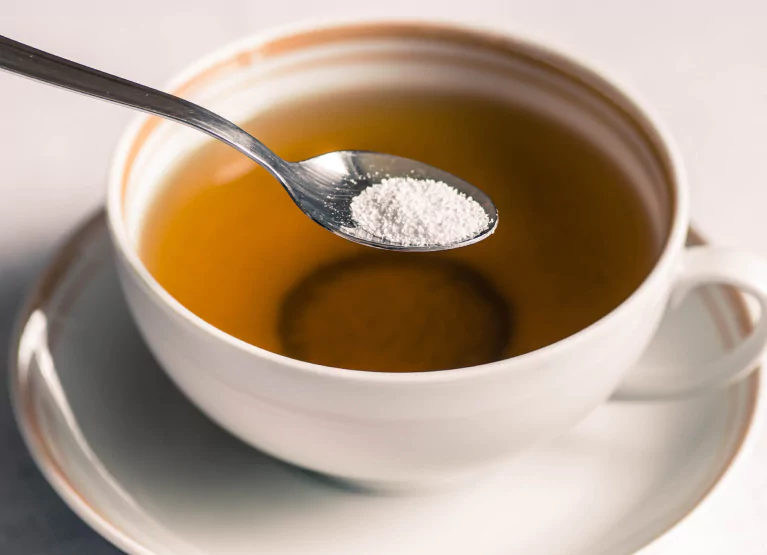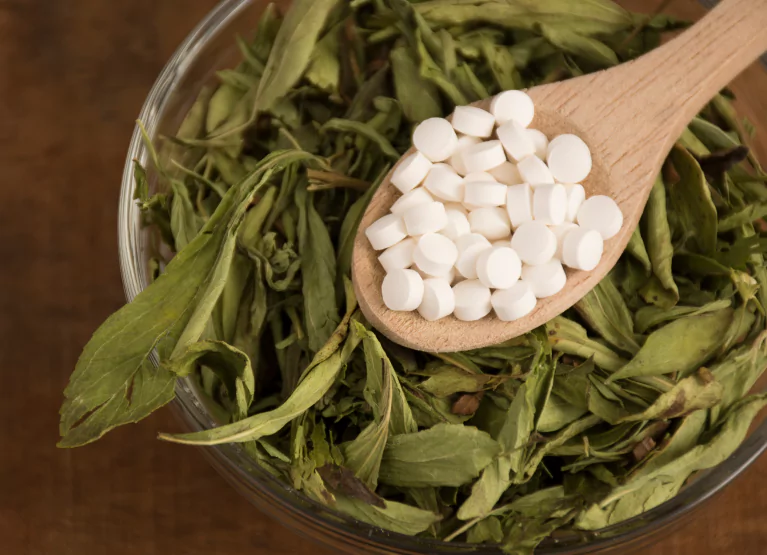Truvia vs. Splenda: Comparing Sweeteners and Blood Sugar Impact

Key Takeways
Stevia and Splenda are two low-calorie sugar substitutes that are widely available in grocery stores and restaurants across the United States.
If you are trying to limit your refined sugar intake but like to enjoy some sweets every now and then, it’s likely that you have encountered these two sweeteners. But is one healthier than the other? And what effect can they have on your health?
Read on to learn more about the similarities and differences of stevia and Splenda.
What is Splenda?

Splenda is a brand of zero-calorie artificial sweetener. It is made from sucralose, which is the only non-caloric sweetener made from sugar. Sucralose is made by replacing three hydroxyl groups in sugar with three chlorine atoms.
Sucralose is 600 times sweeter than sugar and is one of the five artificial sweeteners approved for use by the FDA. Because sucralose cannot be broken down by the body, it imparts zero calories when eaten.
Splenda also contains dextrose and maltodextrin, which are preservatives and sweeteners made from starch. Splenda is available in packets, as a granulated sugar substitute, and in liquid form.
What is Stevia?
Stevia leaf extract is a natural sweetener with zero calories. It is derived from a perennial shrub plant called Stevia rebaudiana. The shrub is part of the Asteraceae family, which also includes daisies, sunflowers, marigolds, artichokes and lettuce.
Stevia’s sweetness comes from compounds called stevioside and rebaudioside A and C, which are 200 to 300 times sweeter than table sugar, or sucrose.
You can purchase pure stevia from brands like SweetLeaf or In the Raw, but keep in mind that some brands of stevia may add highly processed sugar substitutes to the mix, so you will want to read the ingredient list of the product you purchase.
For example, Truvia, a common brand of stevia products, also contains a synthetic sugar alcohol called erythritol. Splenda’s stevia products also contain erythritol.
Comparing Stevia and Splenda

Stevia and Splenda may look similar at first glance, but they are actually quite different. Let’s take a look at some of their differences.
Natural Sweetener vs. Artificial Sweetener
Stevia (or stevia extract) is considered to be a type of natural sweetener, while sucralose is an artificial sweetener. Natural sweeteners come from natural sources that contain calories and nutrients that are metabolized by the body.
Many natural sweeteners come from plant sources. However while stevia itself is considered a natural sweetener, some brands include additives that are considered artificial.
Artificial sweeteners, on the other hand, are synthetic sugar substitutes that have virtually no calories. These sweeteners are regulated by the U.S. Food and Drug Administration as food additives. They are often much sweeter than sugar, meaning that you usually have to use less of them to get the same effect as table sugar.
The effect of artificial sweeteners on health is controversial. Some studies suggest that consuming products with artificial sweeteners can contribute to weight gain, metabolic syndrome, and type 2 diabetes.
However, other studies have refuted these claims, finding that artificial sweeteners may indeed be helpful for weight management compared to regular sugar consumption. Other research has not found an apparent link between artificial sweeteners and other adverse health effects.
Currently, artificial sweeteners like sucralose are considered safe by the FDA.
How Are They Used?

As we mentioned, stevia is sold as a tabletop sweetener under many brand names, including Splenda Naturals, Stevia in the Raw, and Truvia. It is sold in single-serving packets, in cubes, in granulated form, and in liquid form depending on its intended uses.
Stevia is also used commercially as a sugar substitute in diet sodas, low-sugar juices, flavored waters, canned fruits, ice cream, yogurt, syrups, baked goods, and many other foods. It can also be used as a sugar substitute in home baking.
Splenda is sold as a tabletop sweetener in liquid form, granulated form, and in single-serving packets. Sucralose, the main sweetening ingredient in Splenda, can also be found as a sugar substitute in many commercial foods, including ice cream, beverages, and baked goods.
Though it is approved by the FDA for general use, some studies have shown that heating splenda can potentially generate toxic compounds, so you may want to avoid using it in baking.
Sweetness and Taste
Stevia is about 200 times sweeter than sugar. Some people find that it leaves a bitter aftertaste. This is because some of the compounds that give stevia its sweet taste can also activate some bitter taste receptors on your tongue.
Splenda, on the other hand, is 600 times sweeter than sugar. Because it’s the only sugar substitute made from sugar, sucralose has a very sugar-like taste without the bitter aftertaste sometimes present in stevia.
Possible Side Effects and Health Concerns
Alternative sweeteners may be associated with negative side effects. Let’s take a look at the possible side effects of Splenda and stevia.
Splenda

While some studies show sucralose has no effect on blood sugar or insulin production, other studies suggest that it may decrease insulin sensitivity. Studies also show that maltodextrin, another ingredient in Splenda, may lead to blood sugar spikes in some people.
As mentioned above, some studies show that Splenda can generate toxic compounds when heated above 250 degrees Celsius, or 482 degrees Fahrenheit. Currently, it is regarded as safe by the FDA, but more research may be needed to determine potential side effects.
Some research indicates that sucralose may have a negative effect on the bacteria in your gut microbiome. Animal studies have suggested that sucralose’s interaction with gut bacteria may play a role in chronic inflammation, but more research is needed to establish a link.
Stevia
Stevia is associated with very few side effects, but studies have shown that stevia may also negatively affect the bacteria in your gut microbiome, though more research is needed to determine the risks.
What are the Pros and Cons of Splenda?

Like many products, there are some pros and cons to Splenda.
Pros
- Splenda is a zero-calorie sweetener and is not absorbed by the body, meaning that it might not be as likely to affect your weight.
- As mentioned earlier, Splenda is 600 times sweeter than regular sugar, so you will likely need to use less of it to reach your desired sweetness level.
- Splenda is widely available in the U.S. and can be purchased in most grocery stores. Splenda packets are often available for use in coffee shops and restaurants.
- Sucralose is non-cariogenic, meaning it doesn’t interact with bacteria in your mouth and will not cause tooth decay.
Cons
- Splenda is an artificial sweetener, which is a category that has a controversial history when it comes to health benefits and side effects. More research is still needed to determine potential long term adverse health effects of these foods.
- Studies have shown that sugar alternatives like artificial sweeteners may increase cravings for sugary foods.
- In one high quality randomized control trial, sucralose was shown to decrease insulin sensitivity in the study participants, which may be a risk factor for developing diabetes.
- Some animal studies have found that sucralose can alter the gut microbiome and increase inflammation. For some people, sucralose's indigestibility may also cause digestive discomfort.
Pros and Cons of Stevia

Let’s take a closer look at some of the benefits and drawbacks of stevia.
Pros
- Because it isn’t absorbed by the body, stevia may not have a negative effect on blood sugar control, insulin production, or fasting blood sugar levels.
- Stevia is also non-cariogenic, meaning it may not cause tooth decay.
- Stevia has a lower carbon and water footprint than many other sweeteners, making it a more sustainable alternative.
- Studies show that as a natural sugar substitute, pure stevia may have health benefits beyond its effect on glycemic control. It may also have anti-inflammatory, antioxidant, anti-cancer, and anti-viral properties. However, more in vivo studies are needed to determine the extent of these effects.
Cons
- Stevia has been known to leave a bitter, licorice-like aftertaste.
- Not all brands of stevia are 100 percent pure or natural, and many contain additives like erythritol. Make sure to read ingredient labels if you’re trying to avoid artificial ingredients.
Stevia vs Splenda: Which is Healthier?

Stevia and Splenda are both calorie-free sweeteners that have been approved for use as a sugar substitute by the FDA.
As we mentioned earlier, stevia doesn’t appear to have an effect on blood sugar or insulin production as a natural sweetener. It is generally associated with very few side effects, but studies suggest that it may have a potential negative effect on healthy gut bacteria in some cases.
Similarly, Splenda has also been observed to negatively affect gut bacteria. However, unlike stevia, some research suggests that the maltodextrin in Splenda may lead to blood sugar spikes in some people.
When taking all this into account, it seems that stevia may have fewer potential side effects in general. While stevia may be a healthier choice if you are looking for a sugar substitute, you should consult a dietitian or medical professional for advice based on your personal health needs or health concerns.
Find the right Nutrisense programto turn insight into progress.
Go Beyond Glucose Data with Nutrisense
Your glucose can significantly impact how your body feels and functions. That’s why stable levels are an important factor in supporting overall wellbeing. But viewing glucose isn't enough. Nutrisense, you’ll be able to learn how to use your body's data to make informed lifestyle choices that support healthy living.
One-to-one coaching
Sign up to access insurance-covered video calls to work with a glucose expert: a personal registered dietitian or certified nutritionist who will help tailor your lifestyle and diet to your goals.
Monitor and measure what matters
With the Nutrisense CGM Program, you can monitor your glucose with health tech like glucose biosensors and continuous glucose monitor (CGM)s, and analyze the trends over time with the Nutrisense App. This will help you make the most informed choices about the foods you consume and their impact on your health.
Find your best fit
Ready to take the first step? Start with our quiz to find the right Nutrisense program to help you take control.

Heather is a Registered and Licensed Dietitian Nutritionist (RDN, LDN), subject matter expert, and technical writer, with a master's degree in nutrition science from Bastyr University. She has a specialty in neuroendocrinology and has been working in the field of nutrition—including nutrition research, education, medical writing, and clinical integrative and functional nutrition—for over 15 years.




